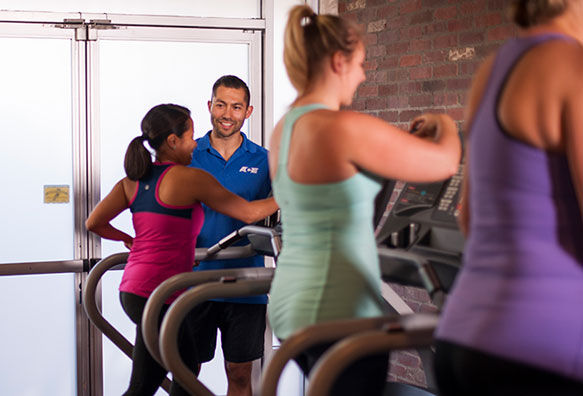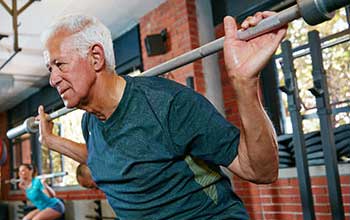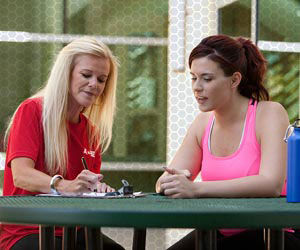
As all health coaches and personal trainers know, self-reliance is a key element of success when it comes to long-term lifestyle modification and self-efficacy. As a health and fitness professional, you educate and empower your clients to make better choices on their own, which makes it possible for them to live healthy lifestyles both inside and outside the fitness facility. While that is certainly a worthwhile goal, does it run counter to the ability to build a thriving business filled with clients who keep coming back over the long haul?
Key Points to Remember
- The mission of every health and fitness professional should be to get people to a point of self-sufficiency and self-reliance, as this creates a healthier, more well population.
- A business model built on creating self-reliance must be built on a steady influx of new clients, which can be achieved, in part, by word-of-mouth referrals from successful clients.
- Consider creating various groups with similar goals, such as a wellness group, a weight-loss group and a weight-maintenance group, which increases social support, provides motivation, accountability and excitement.
In other words, will encouraging the development of self-reliance in your clientele eventually lead to them no longer needing your services?
We turned to three experts—a researcher, a small business owner and an independent personal trainer—to learn how to find the perfect balance between encouraging clients’ self-reliance while also creating a sustainable business model.
In the ACE Health Coach Manual chapter entitled “Helping Clients Establish Self-reliance,” Michelle Murphy Zive, Ph.D., M.S., R.D., a researcher at the UCSD Center for Community Health, writes:
[Helping clients become self-reliant] may seem counterintuitive, and some health coaches may be hesitant to coach this way, saying, “What happens if every one of my clients becomes self-reliant? They will not need me and then what will happen to my business?”
These are similar to questions every parent ponders: What happens if my child leaves for college and does not need me anymore? It is the job of parents to teach children to grow confident in their own abilities to navigate the world successfully. If a child is allowed his or her independence, he or she will be back to get more “coaching” when issues or challenges arise.
Dr. Zive states that the mission of every health and fitness professional should be to get people to a point of self-sufficiency and self-reliance, as this creates a healthier, more well population. “You will have a lot of opportunities to have people succeed in your business,” she says. “Coaching should be a lifelong endeavor, and you need to maintain the connections with your clients in order to create lifelong success.”
But, how do you balance that with your business goals? Is that model really sustainable?
“What is sustainable,” Dr. Zive responds, “is having a way for people to progress so that you create a pipeline—really more of a cycle—that feeds itself.”
Self-reliance as a Selling Point

How to Help Clients Become Self-reliant
In her chapter in the ACE Health Coach Manual, Michelle Murphy Zive, Ph.D., M.S., R.D., offers five strategies for helping clients establish self-reliance:
- Establish self-efficacy through goal setting: Setting realistic goals is the first step in developing rapport in the client–coach/trainer relationship, and accomplishing goals early in the process can help the client feel more confident in his or her efforts.
- Encourage clients to practice behaviors on their own: You should give clients the tools, confidence and support to implement the behaviors you have taught them on their own. They have to be able to continue their efforts outside your facility or office in order to have long-term success.
- Help clients find and implement a support system: Positive social support is absolutely essential, which is one reason why Doug Balzarini’s gym is so good at retaining clients and pushing them to make progress. You can also help build a social-support system outside the gym by discussing the role of coworkers, family members and friends.
- Help clients create or maintain an environment that fosters success: Each client’s “environment” is different, but may include home, work, school, church, community and the fitness facility. In each of those places, the client can identify both positive and negative cues and work to optimize the environment for success.
- Find ways to cope with setbacks: Both short-term lapses and long-term relapses are inevitable. When these occur, it is your job to remind clients of earllier successes, as well as strategies that they have used in the past to keep themselves on track.
It’s important to note that self-reliance, like self-efficacy, is often situation- or task-specific. For example, one client may do a great job of going for a walk every evening after dinner but struggle to eat a healthy lunch while at the office, while another may consistently stick to a healthy eating plan but miss his workout sessions on a regular basis. This is where individualized coaching becomes so important.
Taylor Pollio, an Asheville-based independent functional movement specialist who sees himself as the bridge between physical therapy and the gym, embodies much of what Dr. Zive describes in his work with clients. His business model typically involves clients buying a batch of weekly sessions (usually six to 10) after participating in a functional movement screening session, then moving to monthly check-in sessions where the program is progressed or regressed as needed.
This model relies on a steady influx of new clients, which Pollio often receives as referrals or as a result of networking. “The key,” he says, “is to build a solid reputation and allow word to spread through the various facilities where you work.
“My initial focus is always on function,” Pollio says, “as well as on what the clients need to do for themselves to be successful in the long run. I want my clients to reach a level where proper function allows them to get fit on their own.”
Of course, Pollio doesn’t simply abandon his clients once they attain adequate function. Instead, he works with them to build programs that can keep moving them forward and is there as a support system if a client falters or if pain or discomfort returns.
The take-away message here is that while the cultivating of self-reliance may seem to cost Pollio income as clients shift from weekly to monthly sessions, the reality is that word-of-mouth spreads through a facility rather quickly. For example, one of the locations where Pollio trains is a physical therapy office that also features a small fitness facility. Many of his clients are former physical therapy patients who are transitioning to working out on their own. His reputation grows tremendously when current patients (and other gym members) see former patients thriving on their own with Pollio’s leadership. Self-reliance, in this case, is the primary objective and, ultimately, his greatest selling point.
Self-reliance as an Element of the Business Model
Doug Balzarini is an ACE Certified Personal Trainer and co-owner of Iron Village in Beverly, Mass., which focuses primarily on small-group training sessions. He says that he has two distinct types of clients come through his door.
Group 1 is made up of individuals with specific issues, ranging from acute injuries to chronic pain. With these clients, Balzarini offers specialized one-on-one training sessions where the development of self-reliance is a major focus—similar to the work Taylor Pollio does with his physical therapy referrals. “It’s essential to make this training truly individualized based on each client’s goals and needs,” says Balzarini.
Group 2 consists of his small-group training clients who are capable of working with less direction than you might see in a personal-training session.
“The best-case scenario,” says Balzarini, “is when someone successfully transitions from that first group to the second and becomes a reliable, ongoing customer.” Once clients make that transition, they usually want to keep coming back for more. Balzarini tells clients that they could work out on their own after graduating from the one-on-one sessions, but they lose out on the energy, culture and competition that they would get in a small-group setting.
Further Your Knowledge
Empowering your clients to make long-term behavior change requires much more than just designing an exercise program. This popular online study course, worth 0.4 CECs, explores how to help clients set meaningful goals by asking questions to determine whether they have a personal stake in their accomplishments. It also covers theories on behavior change and the principles of lifestyle modification, as well as self-monitoring and relapse prevention techniques, which can help improve adherence and increase your clients self-reliance.

Coaching Fundamentals: Strategies for Behavior Modification
Balzarini acknowledges that some of the small-group sessions that take place at Iron Village can be intimidating for non-athletes who just want to get fit. In these cases, he recommends being a bit strategic when introducing reluctant clients to the idea of making the switch. “I like to schedule one-on-one sessions so that my clients can see the groups in action,” he says. “That way, they can see that the competition is always friendly and the amount of social support is off the charts. We’ve worked hard to cultivate a motivating, challenging environment.”
Dr. Zive also points out how important social support is in driving clients’ success. “Social support provides feedback, encouragement and coaching from your peers. The idea is to build a group that wants to stay together.” She suggests creating various groups with similar goals, such as a wellness group, a weight-loss group and a weight-maintenance group. “Having appropriate social support,” says Dr. Zive, “allows you to coach each client as a whole person.”
Balzarini echoes the importance of a like-minded group of individuals striving for similar goals. “If clients are working with a group of people who provide motivation, accountability and excitement,” he says, “very few of them will decide they’re better off on their own. Self-reliance, within the context of your programming, will keep them on board.”





 by
by 




